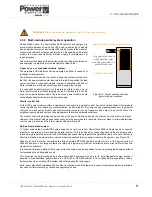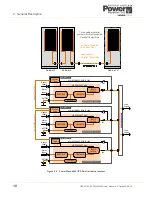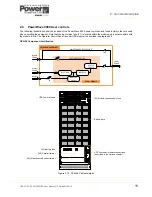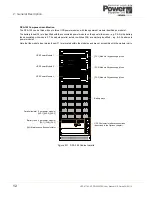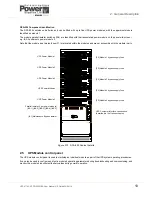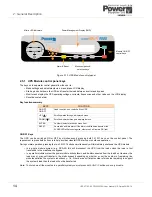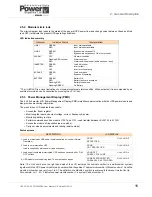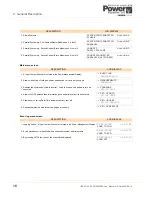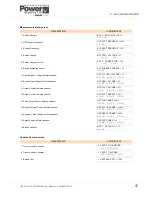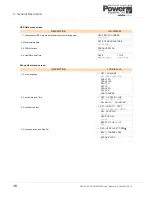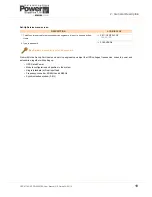
2: General Description
4
UPS471-02-00 PW9000DPA User Manual UK Dated 06/08/14
2.2.1 Advanced design features
Hot-swappable modules
In a redundant module system the unique ‘hot-swappable’ feature enables a UPS power module to be inserted or
removed from its cabinet whilst it is still powered (
hot
) without having to shut down the load or transfer it to the bypass
supply.
Note:
In a non-redundant system the load will unavoidably have to be transferred to the bypass supply while a module is
shut down or removed from the system.
Advanced booster technology
The UPS power module’s inbuilt advanced booster technology results in a perfect sinusoidal input power quality at 0.99
input power factor with a harmonic content of less than 3% THD(i). This leads to a more reliable system operation together
with savings in generator and transformer sizing due to reduced winding losses; and also means that traditional input
harmonic filters (still used by some systems) are not required.
The high power factor presented by the UPS on the incoming mains supply minimises cabling and fusing costs due to the
reduced reactive power consumption which, together with the accompanying low harmonic currents, provides the
following benefits:
• No additional losses in wires and cables
• No extra heating of transformers and generators
• No over sizing of generators
• No false circuit breaker tripping and malfunction
• No erratic operation of computers, telecommunications, monitors, electronic test equipment etc.
• No resonance with power factor correction capacitors
Flexible battery management (FBM)
Premature battery deterioration is avoided by the advanced management of battery charging and preventive failure
diagnostics. The major benefits are:
• AC-ripple-free battery charging due to a dedicated dc-dc charger independent from the rectifier and inverter
• Wide range of number of battery blocks (30-50 x 12V blocks, depending autonomy times)
• Wide UPS input voltage operating window extends the battery life due to fewer discharge cycles
• Battery discharge protection caused by load jumps
• Proactive battery protection from false manipulations and inadequate charging voltages
• Proactive battery failure detection thanks to the Advanced Battery Diagnosis (ABD) algorithm
• User-selectable battery tests to ascertain the battery state
• Optional temperature compensated charging regime to enhance battery life
Decentralised Parallel Architecture (DPA)
In a ‘redundant’ parallel UPS system the power modules’ outputs are connected in parallel so that if one module fails the
remaining modules can sustain the load supply. Such operation requires a certain amount of inter-module communication
to control frequency synchronisation, load sharing, load transfer etc. This is achieved by having a
master-slave
relationship among the power modules whereby the
master
logic gives out individual commands to all the
slave
units to
keep them in step.
In some designs this can unfortunately lead to a single-point-of-failure for the entire system if the master logic or
communication with the slaves fails; however, the PowerWave 9000 technology uses
multi-master
logic with separated
independent regulation and control logic busses which enables
any
of the connected power modules to adopt the
master
role if called upon. This control philosophy maintains the highest possible system availability.
This unique decentralized design:
• Enables a parallel redundant system providing 100% conditioned power at all time
• Eliminates the system-level single point of failure inherent in traditional parallel UPS systems
• Exponentially increases the reliability of the overall system

















